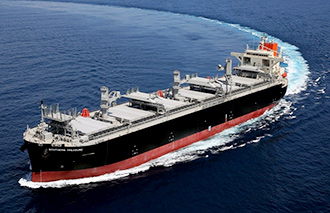- JP
- EN
Wood Chip Carrier "SOUTHERN TREASURE" Delivered
-Will Serve Hokuetsu Corporation-
November 05, 2019

"SOUTHERN TREASURE" at sea trial
TOKYO-Mitsui O.S.K. Lines, Ltd. (MOL; President & CEO: Junichiro Ikeda) today announced that on October 31, the wood chip carrier SOUTHERN TREASURE with a cargo capacity of 4.3 million-cubic feet, was delivered at Oshima Shipbuilding Co., Ltd. (President: Eiichi Hiraga; Headquarters: Saikai-shi, Nagasaki Prefecture). MOL will operate the vessel, which transport wood chips for Hokuetsu Corporation (President & CEO: Sekio Kishimoto; Headquarters: Chuo-ku, Tokyo).
The vessel is equipped with a SOx scrubber and Ballast Water Management System (BWMS) to comply with today's stricter environmental regulations (Note 1). It features Oshima Shipbuilding's technologies such as Seaworthy Bow (a bow shape that reduces the decline in vessel speed during adverse weather), a cutting-edge hull shape with an improved stern shape, and Advanced Flipper Fins (energy-saving equipment to improve propulsion efficiency), and Propeller Boss Cap Fins (PBCF) (Note 2). This environment-friendly vessel also features an electronically controlled engine and low-friction ship bottom paint, achieving a significant reduction of carbon dioxide (CO2) emissions in comparison with ordinary wood chip carriers.
The name of the vessel "SOUTHERN TREASURE" is derived from its cargo, wood chips, which are produced in Chile, South Africa, Australia, Vietnam, and other Southern countries, and represent "treasure" delivered to Hokuetsu Corporation. It also calls to mind the idea of a "treasure ship."
MOL continually strives to offer safe and stable wood chip transport service for customers including paper manufacturers around the world while caring for the environment, and contribute to a stable supply of resources.
[ Outline of the vessel ]
| LOA | 210.00m |
|---|---|
| Breadth | 37.00m |
| Depth | 22.80m |
| Cargo hold capacity | 4,326,015 cubic feet |
(Note 1)
- Emissions regulations: Regulations to prevent air pollution generated by merchant vessels were established in Annex VI issued in 2005 of the MARPOL Treaty adopted by the International Maritime Organization (IMO). Since then, emissions regulations have been strengthened on a global scale. Starting in January 2020, the allowable sulfur content in ship fuel oil in general sea areas will be reduced from the current 3.5% to 0.5% or less (this measure already took effect in designated areas effective January 2015). This will require the use of regulation-compliant bunker oil or installation and use of SOx scrubbers on vessels.
- The Ballast Water Management Convention: A September 2017 treaty requires the control and management of ballast water and sediment discharges. Ballast water, which is taken onboard to stabilize vessel, can move aquatic organisms to non-native habitats, where they might threaten biodiversity and harm local ecosystems. Vessels from countries ratifying the treaty are required to install an IMO-certified BWMS (Ballast Water Management System) to ensure that the number of marine organisms contained in ballast water is below the regulated level.
(Note 2)
Propeller Boss Cap Fins (PBCF) is an energy-saving system to improve propeller efficiency and reduce vessel fuel consumption, and was developed by a group of companies including MOL.
